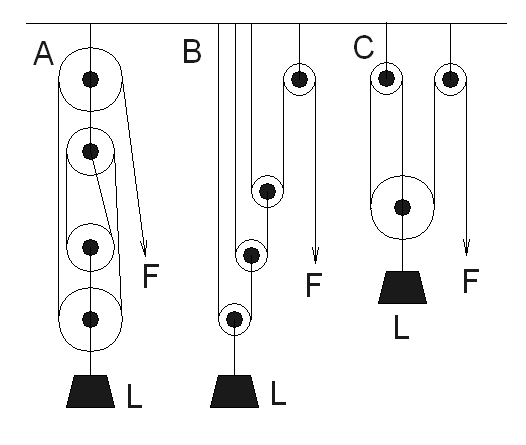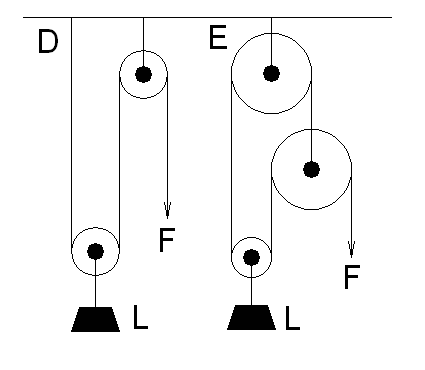M-4 PULLEY SYSTEMS
1. THEORY
Read the theory section of experiment M-3. Also review the sections on force solution of equilibrium systems in any text.
2. APPARATUS
Pulleys, strings, weights, weight hangers, support rods and hardware.
3. PROCEDURE
Pulley systems allow one to lift heavy loads using forces much smaller than the weight of the load. Generally a force applied to a rope supplies the input work. This force usually acts in a direction parallel to the motion of the load.
Figs. A-E illustrate various types of pulley systems. W is the load. F is the applied force to lift the load. For each of these, do the following.
 |
 |
(1) The ideal mechanical advantage is the ratio W/F of the system if all components were weightless and frictionless, and the rope was weightless, inextensible and perfectly flexible. It is equal to the displacement ratio f/w where w is the load displaement and f is the corresponding displacement of the applied force. Prove this relation. Calculate the ideal mechanical advantage for each system (a) by a force analysis, and (b) by a calculation of the displacement ratio. The force analysis is done in the static case, calculating the required input force to just balance the system in equilibrium. [In older textbooks the ideal mechanical advantage was called the theoretical mechanical advantage.]
(2) Select a heavy load, at least 10 times as heavy as the total weight of the pulleys, and set up the system. Determine experimentally how much force to apply to the input string to balance the system. Apply this force by hanging weights on that string. Compare the experimental value of mechanical advantage with the theoretical value.
(3) Measure the displacement ratio, and compare it with your previous calculation.
(4) Compute the efficiency of the system. The efficiency is the ratio of (actual mechanical advantage)/(ideal mechanical advantage).
Some of these pulley systems have names:
System A: block and tackle. System B: Spanish burton. A version of this with more pulleys is shown in one of Leonardoo da Vinci's notebooks..
4. QUESTIONS
(1) The ideal mechanical advantage of a block and tackle (such as system A) is equal to the number of ropes supporting the load. Does this rule work for the other systems?
(2) Why do you suppose system E is sometimes called the "fool's tackle"?
Text and drawings © 1997, 2004, 2021 by Donald E. Simanek.
Return to the contents page of this lab manual.
Return to the top of this document.
Return to Donald Simanek's home page.